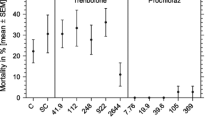Abstract
The Organisation for Economic Co-operation and Development (OECD) Test Guidelines Programme is involved in the international harmonisation and validation of test methods to evaluate effects of chemicals, including potential endocrine active substances. To meet their existing and foreseen regulatory needs in this area, OECD member countries have encouraged the development of test methods and their emergence at the OECD level. Validation activities are underway in countries and industry to ascertain the relevance and reliability of these tests to enable future regulatory acceptance. This includes work on development and (sexual) reproduction of aquatic invertebrates. What is the importance of mechanistic information in regulating chemicals, and how to address the issue of possible endocrine disruption in invertebrates while integrating these tests in a regulatory scheme are the current questions faced by the OECD countries.

Similar content being viewed by others
References
Andersen HR, Wollenberger L, Halling-Sorensen B, Kusk KO (2001) Development of copepod nauplii to copepodites—a parameter for chronic toxicity including endocrine disruption. Environ Toxicol Chem 20:2821–2829
Breitholtz M, Wollenberger L, Dinan L (2003a) Effects of four synthetic musks on the life cycle of the harpacticoid copepod Nitocra spinipes. Aquat Toxicol 63:103–118
Breitholtz M, Wollenberger L (2003b) Effects of three PBDEs on development, reproduction and population growth rate of the harpacticoid copepod Nitocra spinipes. Aquat Toxicol 64:85–96
Brown RJ, Rundle SD, Hutchinson TH, Williams TD, Jones MB (2003) A copepod life-cycle test and growth model for interpreting the effects of lindane. Aquat Toxicol 63:1–11
Brown RJ, Rundle SD, Hutchinson TH, Williams TD, Jones MB (2005) A microplate freshwater copepod bioassay for evaluating acute and chronic effects of chemicals. Environ Toxicol Chem 24:1528–1531
Chandler GT, Cary TL, Volz DC, Walse SS, Ferry JL, Klosterhaus SL (2004) Fipronil effects on estuarine copepod (Amphiascus tenuiremis) development, fertility, and reproduction: a rapid life-cycle assay in 96-well microplate format. Environ Toxicol Chem 23:117–124
deFur P, Crane M, Ingersoll C, Tattersfield L (eds) (1999) Endocrine disruption in invertebrates: endocrinology, testing and assessment. SETAC Pensacola, FL
Duft M, Schmitt C, Bachmann J, Brandelik C, Schulte-Oehlmann U, Oehlmann J (2006) Prosobranch snails as test organisms for the assessment of endocrine active chemicals—an overview and a guideline proposal for a reproduction test with the freshwater mudsnail Potamopyrgus antipodarum. Ecotoxicology DOI 10.1007/s10646-006-0106-0
EPA (US Environmental Protection Agency) (1996) Ecological Effects Test Guidelines OPPTS 850.1350 Mysid Chronic Toxicity Test. Public Draft. EPA 712-C-96-120. US Environmental Protection Agency, Office of Prevention, Pesticides and Toxic Substances, Washington, DC
Huet MC (2000) OECD activity on endocrine disrupters Test Guidelines development. Ecotoxicology 9:77–84
Hutchinson TH (2002) Reproductive and developmental effects of endocrine disrupters in invertebrates: in vitro and in vivo approaches. Toxicol Lett 131:75–81
Kusk KO, Wollenberger L (2006) Towards an internationally harmonised test method for reproductive and developmental effects of endocrine disrupters in marine copepods. Ecotoxicology DOI 10.1007/s10646-006-0112-2
Matthiessen P, Gibbs PE (1998) Critical appraisal of the evidence of tributyltin-mediated endocrine disruption in molluscs. Environ Toxicol Chem 17:37–43
McKenney CL, Celestial DM (1996) Modified survival, growth and reproduction in an estuarine mysid shrimp (Mysidopsis bahia) exposed to a juvenile hormone analogue through a complete life-cycle. Aquat Toxicol 35:11–20
Oda S, Tatarazako N, Watanabe H, Morita M, Iguchi T (2005a) Production of male neonates in Daphnia magna (Cladocera, Crustacea) exposed to juvenile hormones and their analogs. Chemosphere 61:1168–1174
Oda S, Tatarazako N, Watanabe H, Morita M, Iguchi T (2005b) Genetic differences in the production of male neonates in Daphnia magna exposed to juvenile hormone analogs. Chemosphere 63:1477–1484
OECD (2002) Report of the Sixth Meeting of the OECD Task Force on Endocrine Disrupters Testing and Assessment. Organisation for Economic Co-operation and Development, Paris
OECD (2005) Guidance Document on the Validation and International Acceptance of New or Updated Test Methods for Hazard Assessment. OECD Environmental Health and Safety Publications, Series on Testing and Assessment No. 34. Organisation for Economic Co-operation and Development, Paris
OECD (2006a) Guidance Document for the Development of OECD Guidelines for Testing of Chemicals, Second Edition. OECD Environmental Health and Safety Publications, Series on Testing and Assessment No. 1. Organisation for Economic Co-operation and Development, Paris
OECD (2006b) Detailed Review Paper on Aquatic Arthropods Life-Cycle Toxicity Testing With Emphasis on Developmental, Reproductive Including Potential Endocrine Disruptive Effects. OECD Environmental Health and Safety Publications, Series on Testing and Assessment No. 55. Organisation for Economic Co-operation and Development, Paris
Oehlmann J, Bettin C (1996) TBT-induced imposex and the role of steroids in marine snails. Malacol Rev Suppl 6 (Molluscan Reproduction):157–161
Oehlmann J, Schulte-Oehlmann U, Bachmann J, Oetken M, Lutz I, Kloas W, Ternes TA (2006) Bisphenol A induces superfeminisation of the ramshorn snail Marisa cornuarietis at environmentally relevant concentrations. Environ Health Perspect 114:127–133
Soin T, Smagghe G (2006) Endocrine disruption in aquatic insects: a review. Ecotoxicology DOI 10.1007/s10646-006-0118-9
Taenzler V, Bruns E, Dorgerloh M, Pfeifle V, Weltje L (2006) Chironomids: suitable test organisms for risk assessment investigations on the potential endocrine disrupting properties of pesticides. Ecotoxicology DOI 10.1007/s10646-006-0117-x
Tatarazako N, Oda S (2006) The water flea Daphnia magna (Crustacea, Cladocera) as a test species for screening and evaluation of chemicals with endocrine disrupting effects on crustaceans. Ecotoxicology DOI 10.1007/s10646-006-0120-2
Tyler CR, Jobling S, Sumpter JP (1998) Endocrine disruption in wildlife: a critical review of the evidence. Crit Rev Toxicol 28:319–361
Verslycke T, Ghekiere A, Raimondo S, Janssen C (2006) Mysid crustaceans as standard models for the screening and testing of endocrine-disrupting chemicals. Ecotoxicology DOI 10.1007/s10646-006-0122-0
Author information
Authors and Affiliations
Corresponding author
Additional information
Opinions expressed in this paper do not necessarily represent those of the OECD and its member countries.
Rights and permissions
About this article
Cite this article
Gourmelon, A., Ahtiainen, J. Developing Test Guidelines on invertebrate development and reproduction for the assessment of chemicals, including potential endocrine active substances—The OECD perspective . Ecotoxicology 16, 161–167 (2007). https://doi.org/10.1007/s10646-006-0105-1
Published:
Issue Date:
DOI: https://doi.org/10.1007/s10646-006-0105-1




